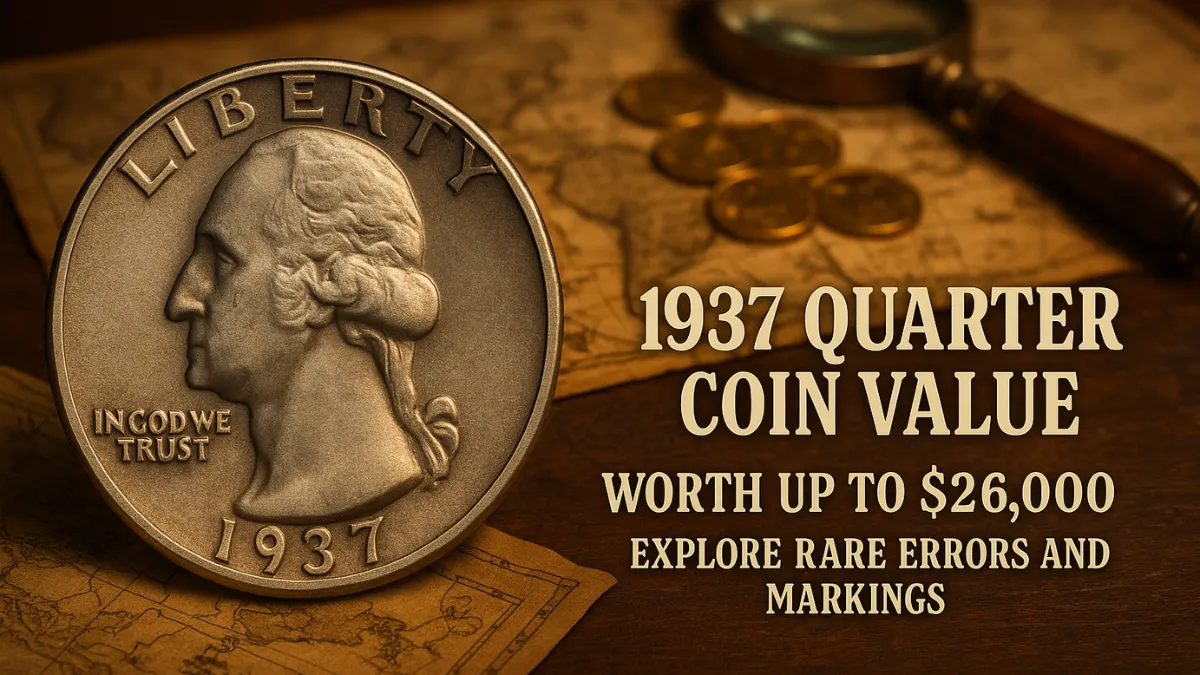1937 Quarter: A Collectible Treasure
Among collectors, the 1937 Washington quarter minted by the U.S. Mint has become a highly sought-after coin. Although its face value is only 25 cents, this quarter has captivated numismatic enthusiasts for decades due to its historical significance and current value. Join us as we dive into the fascinating history of the 1937 quarter and explore what makes it so valuable.
1937 Quarter Value Chart
| Mint Mark | Good | Fine | Extremely Fine | Uncirculated |
|---|---|---|---|---|
| 1937 No Mint Mark Quarter | $8.50 | $9.50 | $20 | $35 |
| 1937 D Mint Mark Quarter | $9 | $12.50 | $25 | $67 |
| 1937 S Mint Mark Quarter | $12.50 | $20 | $60 | $190 |
1937 Quarter Grading
Grading is an essential step in coin collecting as it helps determine a coin’s value and authenticity. The 1937 quarter, like other coins, can be graded from poor to mint state. Key factors like surface preservation, strike quality, brilliance, and overall appeal are taken into account when grading a coin. Here’s how the grading system works:
| Grade | Description |
|---|---|
| 1 (Basal State-1) | Poor |
| 2 (Fair) | Very Poor |
| 3 (Very Fair) | Fair |
| 4, 5, 6 (Good) | Good |
| 7, 8, 10 (Very Good) | Very Good |
| 12, 15 (Fine) | Fine |
| 20, 30 (Very Fine) | Very Fine |
| 40 (Extremely Fine) | Extremely Fine |
| 50 (About Uncirculated) | Near Mint |
| 60 (Mint State) | Mint State |
| 65 (Mint State) | Mint State |
| 70 (Mint State) | Mint State |
Check our guides for more detailed information on how to grade Washington quarters to determine their precise value.
1937 No Mint Mark Quarter Value
The 1937 quarters without a mint mark were struck in Philadelphia, the oldest U.S. Mint, which has been operational since 1792. The lack of a mint mark signifies the coin’s origin from this historic facility. The design of the 1937 No Mint Mark Quarter, featuring George Washington’s profile and an eagle with wings outstretched, makes it highly desirable for collectors.
The coin’s value can vary dramatically based on its condition, ranging from just a few dollars for worn specimens to thousands for coins in pristine condition. Rare, well-preserved examples with little wear, a shiny silver finish, and minimal toning are especially prized.
1937 D Mint Mark Quarter Value
The 1937 D quarter was produced at the Denver Mint, which has been operational since 1906. Minted during the U.S. recovery from the Great Depression, this coin features a robust design of George Washington, flanked by the inscriptions “Liberty” and “In God We Trust.” The reverse shows an eagle holding an olive branch and arrows, with the mint mark “D” identifying its Denver origin.
A total of 7,189,600 of these quarters were struck, and while many are still in circulation, rare varieties, especially those in high-grade condition or exhibiting unique flaws, can fetch impressive prices. The highest price ever paid for a 1937 D Quarter was $7,931 for a PCGS MS-67+ specimen sold at auction in 2013.
1937 S Mint Mark Quarter Value
Produced at the San Francisco Mint, the 1937 S quarter is relatively rare with a mintage of just over 1 million. The San Francisco Mint, which has been operational since the California Gold Rush of 1854, has produced many iconic coins, including the Walking Liberty Half Dollar and Mercury Dime.
Coins in excellent condition, particularly those with complete strike details or attractive patina, can command higher prices. A 1937 S quarter graded MS67+ by PCGS sold for $16,800 in 2021, setting a record for this coin type.
Rare 1937 Quarter Error List
Collectors often seek rare errors, and the 1937 quarter features several notable ones:
- Die Cracks: Small fissures in the die surface can create cracks on the coin, adding uniqueness.
- Cuds: Raised lumps on the coin, often from a damaged die, make the coin more appealing to collectors.
- Clipped Planchet: These occur when a portion of the coin’s edge is missing due to incomplete metal before striking.
- Off Center Strike: When the coin is not struck centrally, creating an off-center design.
- Double Die: A coin that shows two sets of images due to a flaw in the die during the minting process.
- Lamination Errors: These are caused by defects in the metal, leading to peeling layers that create a raised blister on the coin’s surface.
Where to Sell Your 1937 Quarter
If you’re ready to sell your 1937 quarter, there are several trusted platforms where you can get an appraisal and connect with buyers. Some well-regarded dealers and auction houses specialize in rare coins and can help you determine the best value for your item.
What Is The Error On The 1937 Quarter?
Errors can vary, including die cracks, clipped planchets, and off-center strikes, adding a unique character that can make the coin more valuable.
How Rare Is A 1937 Quarter?
While over 27 million 1937 quarters were produced, coins in exceptional condition or with rare errors are much less common and therefore more valuable.
How Do I Know If My 1937 Quarter Is Worth Anything?
A coin’s value depends on its condition, mint mark, and any errors it may have. Consulting a pricing guide or a professional grader can help you determine its worth.
Where Is The Mint Mark On A 1937 Coin?
The mint mark is located on the reverse, beneath the eagle’s tail feathers. If there is no mint mark, it was struck in Philadelphia. “D” indicates Denver, and “S” stands for San Francisco.
